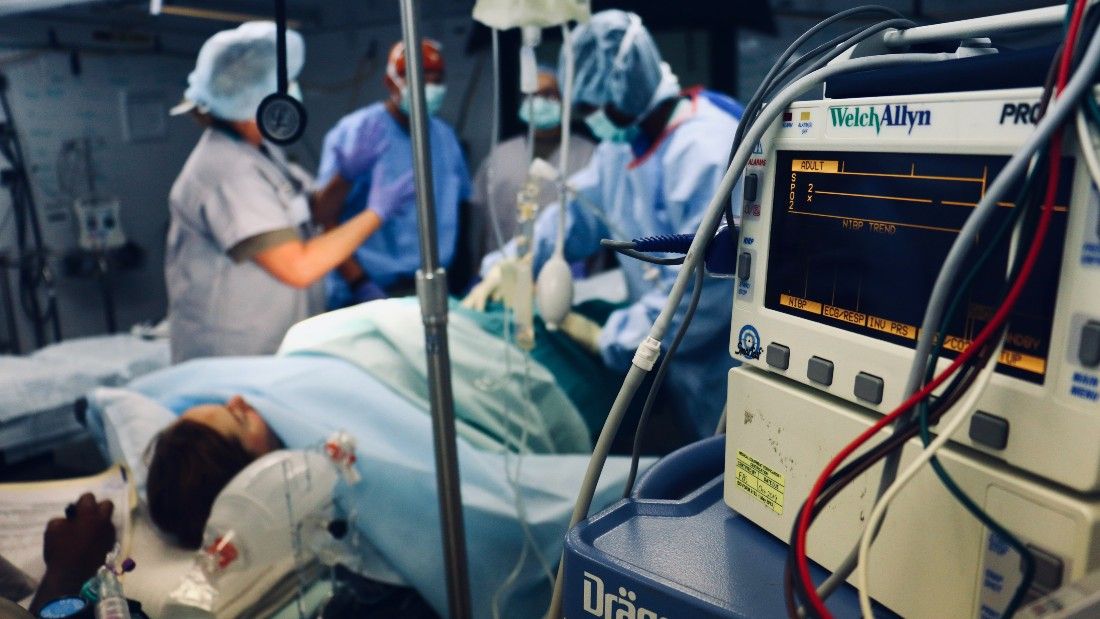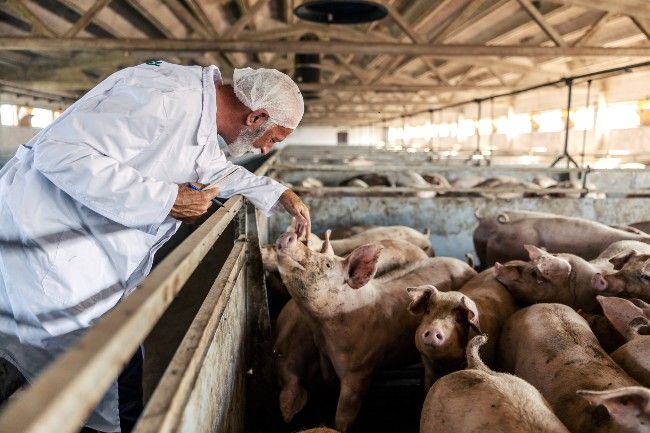Staphylococcus Aureus and MRSA

Staphylococcus aureus is recognised worldwide as a pathogen causing many serious diseases in humans and animals. Since the 1960s, a strain resistant to penicillin and methicillin (and now, several other antibiotics), called methicillin-resistant S. aureus (MRSA) has spread as a human hospital-acquired pathogen throughout the world. More recently, community-acquired and livestock-associated MRSA have emerged and are an increasing source of concern.
S. aureus is a type of bacteria found on people’s skin. They are usually harmless, but can cause serious infections that can lead to sepsis or death. In 1959, the antibiotic methicillin was introduced in the UK to treat infections caused by penicillin-resistant S. aureus but then in 1961 there were reports from the UK of strains that had acquired resistance to methicillin. MRSA isolates were soon recovered from other European countries and later from Japan, Australia and the US.5Enright MC, Robinson DA, Randle G et al. 2002. The evolutionary history of methicillin-resistant Staphylococcus aureus (MRSA). Proceedings of the National Academy of Sciences USA. 99 (11) 7687-7692.
Infections with methicillin-resistant S. aureus (MRSA) can be harder to treat than other bacterial infections as they are resistant to several widely used antibiotics.6NHS. 2020. MRSA. Available: https://www.nhs.uk/conditions/mrsa/ [Accessed 3 June 2022].
S. aureus lives harmlessly on the skin of around one in 30 people – usually in the nose, armpits, groin or buttocks. Around one to three per cent of the population are colonised with MRSA and in most cases no treatment is necessary, as colonisation does not lead to any harmful infection. This is known as “carrying” MRSA.
You can get MRSA on your skin by touching someone who has it, sharing towels, sheets or clothes with someone who carries it, or touching surfaces or objects that have MRSA on them. Getting MRSA on your skin will not make you ill, and it may go away in a few hours, days, weeks or months without you noticing. But it could cause an infection if it gets deeper into your body.2NHS. 2020. MRSA. Available: https://www.nhs.uk/conditions/mrsa/ [Accessed 3 June 2022].
MRSA can cause harm when it enters the body. It may cause skin infections, pimples or boils, or more serious potentially life-threatening problems such as wound or chest infections (pneumonia). In some cases, invasive MRSA infection may affect heart valves or bones and can lead to abscesses in organs, joint infections, or bloodstream infection (sepsis).
Hospital patients are most at risk of this happening because they often have a way for the bacteria to get into their body, such as a wound, burn, feeding tube, drip into a vein or a urinary catheter. They may also have other serious health problems that mean their body is less able to fight off the bacteria. Healthy people, including children and pregnant women, are not usually at risk of MRSA infections.2NHS. 2020. MRSA. Available: https://www.nhs.uk/conditions/mrsa/ [Accessed 3 June 2022].
MRSA remained largely confined to hospital settings, where it was first detected, until the 1990s.7Aires-de-Sousa M. 2017. Methicillin-resistant Staphylococcus aureus among animals: current overview. Clinical Microbiology and Infection. 23, 6, 373-380. Since then, there has been an explosion in so-called community-acquired MRSA, responsible for a large proportion of the increased disease burden observed in recent years.8David MZ and Daum RS. 2010. Community-associated methicillin-resistant Staphylococcus aureus: epidemiology and clinical consequences of an emerging epidemic. Clinical Microbiology Reviews. 23 (3) 616-687. MRSA is no longer exclusive to hospitals and the prevalence of community-acquired infections in people that have had no contact with hospital environments is increasing.

In recent years, new livestock-associated strains of MRSA have also been emerging.16Igrejas G, Correia S, Silva V et al. 2018. Planning a One Health Case Study to Evaluate Methicillin Resistant Staphylococcus aureus and Its Economic Burden in Portugal. Frontiers in Microbiology. 9, 2964. Farmed animals can be carriers, can become infected or can act as a reservoir for transmission to humans.17Haag AF, Fitzgerald JR, Penadés JR. 2019. Staphylococcus aureus in Animals. Microbiology Spectrum. 7 (3). This versatile pathogen has established new reservoirs and is now widespread in the community and animals, especially livestock.3Aires-de-Sousa M. 2017. Methicillin-resistant Staphylococcus aureus among animals: current overview. Clinical Microbiology and Infection. 23, 6, 373-380. Rising numbers of MRSA infection and colonisation in farmed animals illustrate how MRSA has become an important zoonotic pathogen.
Different strains of MRSA have emerged in livestock across different regions of the world. The predominant livestock-associated strain in Europe and North America is called ST398.18Pirolo M, Visaggio D, Gioffrè A et al. 2019. Unidirectional animal-to-human transmission of methicillin-resistant Staphylococcus aureus ST398 in pig farming; evidence from a surveillance study in southern Italy. Antimicrobial Resistance and Infection Control. 8, 187. MRSA ST398 has been reported in farmed animals from various countries. It is most prevalent in pigs, which are a major reservoir of ST398 in Western countries, including Italy, where a high prevalence has been documented in farms over the past decade.7Pirolo M, Visaggio D, Gioffrè A et al. 2019. Unidirectional animal-to-human transmission of methicillin-resistant Staphylococcus aureus ST398 in pig farming; evidence from a surveillance study in southern Italy. Antimicrobial Resistance and Infection Control. 8, 187. In the Netherlands, the largest exporter of live pigs in Europe, up to 39 per cent of pigs carry MRSA in their nostrils or nasal passages.19Krziwanek K, Metz-Gercek S, Mittermayer H. 2009. Methicillin-Resistant Staphylococcus aureus ST398 from human patients, upper Austria. Emerging Infectious Diseases. 15 (5) 766-769.
The first report of MRSA in pigs was from the Netherlands in 2005.20Voss A, Loeffen F, Bakker J et al. 2005. Methicillinresistant Staphylococcus aureus in pig farming. Emerging Infectious Diseases. 11 (12) 1965-1966. In this study, a pig, a six-month-old girl and her parents who lived on a pig farm, as well as other pig farmers, were all colonised by the same strain of MRSA ST398. Soon after the isolation of MRSA in Dutch pigs, ST398 was recovered from pigs in different European countries.3Aires-de-Sousa M. 2017. Methicillin-resistant Staphylococcus aureus among animals: current overview. Clinical Microbiology and Infection. 23, 6, 373-380. A large European survey looking for MRSA in the dust of pig holdings, detected it in 17 out of 26 countries. Higher rates were found in countries with higher densities of pig farming.3Aires-de-Sousa M. 2017. Methicillin-resistant Staphylococcus aureus among animals: current overview. Clinical Microbiology and Infection. 23, 6, 373-380.
In the UK, S. aureus is one of the three main bacteria that cause mastitis in dairy cows, along with Streptococcus uberis and E. coli. In Belgium, MRSA is an established cause of clinical mastitis in cows.21Fergestad ME, De Visscher A, L’Abee-Lund T et al. 2021. Antimicrobial resistance and virulence characteristics in 3 collections of staphylococci from bovine milk samples. Journal of Dairy Science. S0022-0302 (21) 00568-3. After the first report of MRSA in bovine mastitis in Belgium, increasing numbers of cases of MRSA in cows and cow’s milk have been reported from all over the world and research shows that ST398 has also emerged in cattle and been found in beef samples.3Aires-de-Sousa M. 2017. Methicillin-resistant Staphylococcus aureus among animals: current overview. Clinical Microbiology and Infection. 23, 6, 373-380.
MRSA ST398 isolates have also been identified in Europe in healthy and diseased chickens as well as in turkeys. This finding, researchers say, indicates that the animal reservoir of MRSA ST398 is broader than previously thought. This, they add, may pose a public health hazard, since it has been shown that MRSA ST398 has zoonotic potential, causing infections in people in contact with carrier animals.22Nemati M, Hermans K, Lipinska U et al. 2008. Antimicrobial resistance of old and recent Staphylococcus aureus isolates from poultry: first detection of livestock-associated methicillin-resistant strain ST398. Antimicrobial Agents and Chemotherapy. 52 (10) 3817-3819.
Livestock-associated strains may evolve in factory farms because of the use of antibiotics used as feed additives for growth promotion in industrial livestock and poultry, for prevention of disease within a herd, or for treatment of an existing disease outbreak.26Smith TC. 2015. Livestock-associated Staphylococcus aureus: the United States experience. PLoS Pathogens. 11 (2) e1004564. Antibiotics used in livestock include many that are also important for human health, including tetracyclines, macrolides, penicillins and sulfonamides, among others.12Smith TC. 2015. Livestock-associated Staphylococcus aureus: the United States experience. PLoS Pathogens. 11 (2) e1004564. The inappropriate use of antibiotics in the treatment of human diseases and non-therapeutic use in animals may have played a significant role in the emergence of resistant strains. Such resistance may pose a great threat to public health if livestock-associated strains enter the community and healthcare settings.27Mehndiratta PL and Bhalla P. 2014. Use of antibiotics in animal agriculture and emergence of methicillinresistant Staphylococcus aureus (MRSA) clones: need to assess the impact on public health. Indian Journal of Medical Research. 140 (3) 339-344.
Livestock-associated MRSA ST398 is now recognised as an occupational hazard for people who work in direct contact with livestock, especially for farmers, abattoir workers and veterinarians. But even just living close to a high-density livestock production facility (factory farm) can increase your risk of exposure.7Pirolo M, Visaggio D, Gioffrè A et al. 2019. Unidirectional animal-to-human transmission of methicillin-resistant Staphylococcus aureus ST398 in pig farming; evidence from a surveillance study in southern Italy. Antimicrobial Resistance and Infection Control. 8, 187. One study found livestock-associated MRSA colonisation in 24-86 per cent of pig farmers, 31-37 per cent of dairy and beef farmers, and nine to 37 per cent of poultry farmers, as well as 44-45 per cent of pig-care veterinarians in European countries.28Anjum MF, Marco-Jimenez F, Duncan D et al. 2019. Livestock-Associated Methicillin-Resistant Staphylococcus aureus From Animals and Animal Products in the UK. Frontiers in Microbiology. 10, 2136.
Antibiotic resistance generated in animal agriculture may spread to people in a number of different ways, including: contact with contaminated meat products (via handling or ingestion); occupational contact (farmers, meat-packers, butchers etc) and secondary spread into the community from those who are occupationally exposed; entry into and transmission via hospitals and other healthcare facilities; or spread via environmental routes including air, water or manure in areas close to livestock farms or crop farms where manure has been used as fertiliser.12Smith TC. 2015. Livestock-associated Staphylococcus aureus: the United States experience. PLoS Pathogens. 11 (2) e1004564.
Although MRSA ST398 is associated with livestock, scientists say that it is a major public health threat to humans in close contact with livestock. A very high prevalence of MRSA ST398 was reported among pig farmers and pigs in Spain, and the data suggests animal-to-human transmission. The cross-transmission between animals and humans, scientists say, poses a high zoonotic threat.30Dweba CC, Zishiri OT, El Zowalaty ME. 2018. Methicillin-resistant Staphylococcus aureus: livestockassociated, antimicrobial, and heavy metal resistance. Infection and Drug Resistance. 11, 2497-2509.
MRSA ST398 has emerged in humans in Europe, China, Thailand and Canada, indicating a great potential for spread. Because the international meat and livestock market is so active, scientists warn that the stage is set for a rapid spread.8Krziwanek K, Metz-Gercek S, Mittermayer H. 2009. Methicillin-Resistant Staphylococcus aureus ST398 from human patients, upper Austria. Emerging Infectious Diseases. 15 (5) 766-769.
As we are fast-approaching a post-antibiotic era, the effectiveness of antibiotics used to treat human illnesses may be reduced if pathogens and resistance genes from the agricultural environment are repeatedly, but silently, being introduced into the human population.12Smith TC. 2015. Livestock-associated Staphylococcus aureus: the United States experience. PLoS Pathogens. 11 (2) e1004564.





